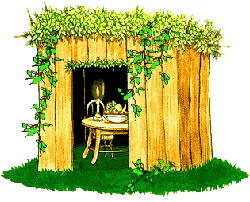|
The sukkah, a fragile hut built of branches and leaves, is the main feature of the Sukkot festival.
|
 |
The origin of the practice of "dwelling in booths" during the festival is
|
The sukkah dwelling today, wherever it is located, retains the feeling of impermanence. The celebration calls for dwelling in sukkah for seven days. While dwelling means eating and sleeping, most people limit their activities to eating and study.
|
Any lightweight material sturdy enough to withstand average regional winds can be used to build the walls of the sukkah. Walls must be between 35 inches and 35 feet high. No Mazuzah is placed on the door jambs.
|
The roof is made of leaves and branches. Openings must be left in it so that the light of the sun, moon, and stars can be seen. In celebration of the harvest, the sukkah is decorated with fruits and vegetables hung from the roof and the walls.
|
Hospitality is a basic element of the holiday. An essential ingredient of Sukkot is sharing meals with others, so there must be room for a table and chairs in the sukkah since we eat and visit with friends in it.
|


 Friendship Day
Friendship Day Good Morning
Good Morning